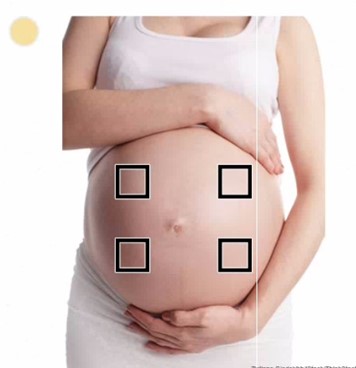A nurse is assessing a client who is at 39 weeks of gestation and determines that the fetus is in a left occipitoanterior position. On which of the following sites should the nurse place the external fetal monitor to hear the point of maximum impulse of the fetal heart rate?

Right upper quadrant
left upper quadrant
left lower quadrant.
right lower quadrant.
The Correct Answer is C
A. This would be appropriate if the fetus were in a breech presentation.
B. This is incorrect because the fetal back is in the lower left quadrant, not the upper quadrant.
C. In the Left Occipitoanterior (LOA) Position, the fetal occiput (back of the head) is facing the mother’s left side and anteriorly (toward the front of the uterus). The fetal back will be on the left side of the maternal abdomen, making the PMI in the left lower quadrant. The best location to place the fetal monitor is over the fetal back, closest to the head. Since the fetus is cephalic (head down) in LOA position, the heart sounds are heard in the left lower quadrant.
D. This would be appropriate if the fetus were in a right occipitoanterior (ROA) position, but in LOA, the back is on the left.
Nursing Test Bank
Naxlex Comprehensive Predictor Exams
Related Questions
Correct Answer is D
Explanation
The correct answer is choice D. Urine output of 20 mL/hr is a manifestation of an adverse reaction to magnesium sulfate. Magnesium sulfate is a medication used to treat preeclampsia, a potentially life-threatening condition that can occur during pregnancy. Adverse reactions to magnesium sulfate include hypotension, respiratory depression, and decreased urine output. The nurse should monitor the client's vital signs and urine output closely while the client is receiving magnesium sulfate. Normal urine output in a healthy individual should be between 0.5-1.5 mL/kg/hour, and patients should generally be urinating at least every 6 hours.
Correct Answer is C
Explanation
"You can expect your breasts to be firm and tender 3 to 5 days after delivery." Postpartum care includes education on physical changes that occur after delivery. It is important for the nurse to inform the client that breast engorgement is a common occurrence and may result in firm, tender breasts 3 to 5 days after delivery. The nurse should also encourage the client to use a breast pump or express milk by hand to relieve discomfort. It is not advisable for the client to rely solely on breastfeeding as a form of birth control, so the nurse should educate the client on the importance of using contraception. Postpartum bleeding is typically bright red
Whether you are a student looking to ace your exams or a practicing nurse seeking to enhance your expertise , our nursing education contents will empower you with the confidence and competence to make a difference in the lives of patients and become a respected leader in the healthcare field.
Visit Naxlex, invest in your future and unlock endless possibilities with our unparalleled nursing education contents today
Report Wrong Answer on the Current Question
Do you disagree with the answer? If yes, what is your expected answer? Explain.
Kindly be descriptive with the issue you are facing.
